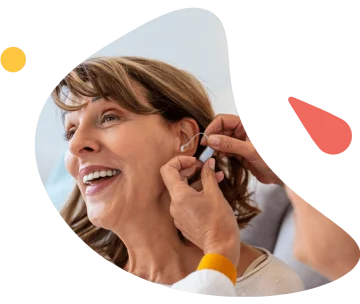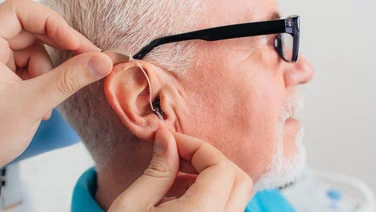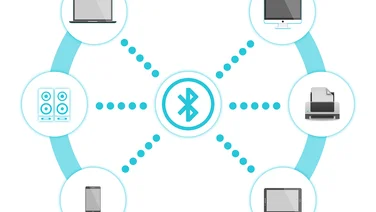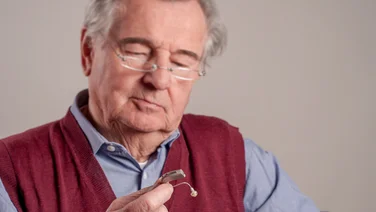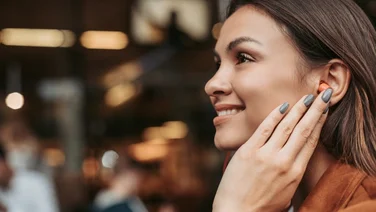There is a deluge of information out there about hearing aids. With an overwhelming amount of terminology and an ever-growing list of hearing aid features and types, it’s easy to get bogged down and confused.
Fortunately, we’ll provide you with an overview of the six main manufacturers of hearing aids – sometimes known as ‘the big six’ – and a few of their top products.
The information that follows is an impartial summary of what each manufacturer has to offer. We haven’t conducted any tests to verify any claims the manufacturers make about their products, nor is this designed to serve as a comparison or review of makes and models of hearing aids.
The best hearing aid for you – the exact type, make, and model – will depend on the nature and severity of your hearing loss, your budget, and/or whether you are eligible for financial assistance towards the cost and upkeep of your hearing aids.
Always speak to your healthcare provider or audiologist for individual advice.
Experiencing hearing loss and think a hearing aid might help?
Talk to an audiologist about what type of hearing aid is best for you.
Oticon
Oticon is a global hearing aid manufacturer that’s headquartered in Copenhagen, Denmark and operates in more than 20 countries. It was founded in 1904 when Dutchman Hans Demant began exploring solutions for his wife Camilla’s hearing impairment.
Oticon’s range of hearing aids spans all different types, from invisible to power aids, to rechargeable hearing aids and devices for children.
As of August 2022, its flagship product is the Oticon More. These models boast Bluetooth, which is compatible with both iOS and Android, and telecoil technology.
Under the Oticon More brand, you’ll find behind-the-ear (BTE) hearing aids with both the receiver in the ear (RITE) and receiver in the canal (RIC) types, and each type available with either rechargeable or disposable batteries.
A number of different color options are available, too
Resound
Also founded in Denmark, this time in 1943, was ReSound, which provides hearing technology to customers in 80 countries worldwide. According to its website, ReSound delivered the very first Made for iPhone hearing aid.
The manufacturer provides the full range of hearing aid types – from basic BTE hearing aids, to invisible in the canal (IIC) designs.
The ReSound One is the manufacturer’s premium range, as of August 2022. It’s a miniature, rechargeable BTE aid, with a receiver in the canal (RIC) design as well as an additional third microphone in the receiver tip.
As the first brand to make iPhone-compatible hearing aids, it streams only with iOS devices, although an app that allows you to check your battery’s status is available on both iOS and Android.
A design update means the ReSound One comes in a variety of neutral and skin tone colors.
Phonak
The history of Phonak, another big six manufacturer, dates back more than 70 years to Switzerland, where it is still based. In 1978 the company went global and as of August 2022, it is represented in more than 100 countries.
Like the rest of the big six, Phonak offers a complete range of hearing aids to suit all kinds and degrees of hearing loss. There are eight BTE hearing aids available from Phonak, as well as two in-the-ear ITE devices, with a range of features and technology.
The company claims ‘the world’s only 100% invisible hearing aid’ in Phonak Lyric.
According to Phonak, you can wear the Lyric hearing aid all day, every day, for months at a time, including when you’re sleeping, showering, and wearing headphones.
Starkey
As well as being the only American-owned global hearing aid manufacturer, Starkey is also among the newest. It began in the 1960s when founder Bill Austin established a hearing aid service and repair company – and he remains at the helm to this day.
Its top products are found in the Starkey Evolv AI range, which comes in behind the ear (BTE), in the ear (ITE), in the canal (ITC), completely in canal (CIC), and invisible in canal (IIC) styles. All but the smallest types are available with disposable and rechargeable batteries.
Starkey reports that its Evolv AI range reduces noise energy by 40% compared to its previous technology, meaning less effort is required to listen and hear more clearly.
Widex
Widex is part of a larger parent company called WS Audiology, another Danish-based global manufacturer of hearing aids. Founded in 1956, Widex markets itself as providing the most natural-sounding and feeling hearing devices.
With its Widex MySound technology in the Widex Moment hearing aid range, the company aims to eliminate the sound delay that can occur between sound reaching the eardrum naturally, and when it’s processed through a hearing aid.
Widex Moment claims advanced water-resistance and has three hearing aid type options: BTE receiver in the ear (RITE), receiver in the canal (RIC) style, and a discreet in the canal (ITC) style.
Signia
Also under the Danish WS Audiology brand umbrella, Signia was only launched globally in 2016 so it’s among the newest manufacturers. It ticks a lot of boxes by providing a large range of types and styles of hearing aids, from basic to advanced.
One of its signature hearing aids is the Signia Active Pro, which is a kind of hybrid between a hearing aid and an earbud. The rechargeable devices are said to have 26 hours of use after each charge.
Signia Active Pro hearing aids can stream, adjust to your acoustic environment, have remote control functioning, and can be personalized via the Signia app available on iOS and Android.
Which hearing aid brand is right for you?
While these are the six most popular hearing aid brands on the market today, there is no credible article online that can tell you which device or brand is best for you. If your hearing is starting to bother you, or is gradually getting worse, it’s always worth speaking to a professional. We can connect you with a local audiologist to get you the help you need. Fill in our quick form and we’ll do the rest.
